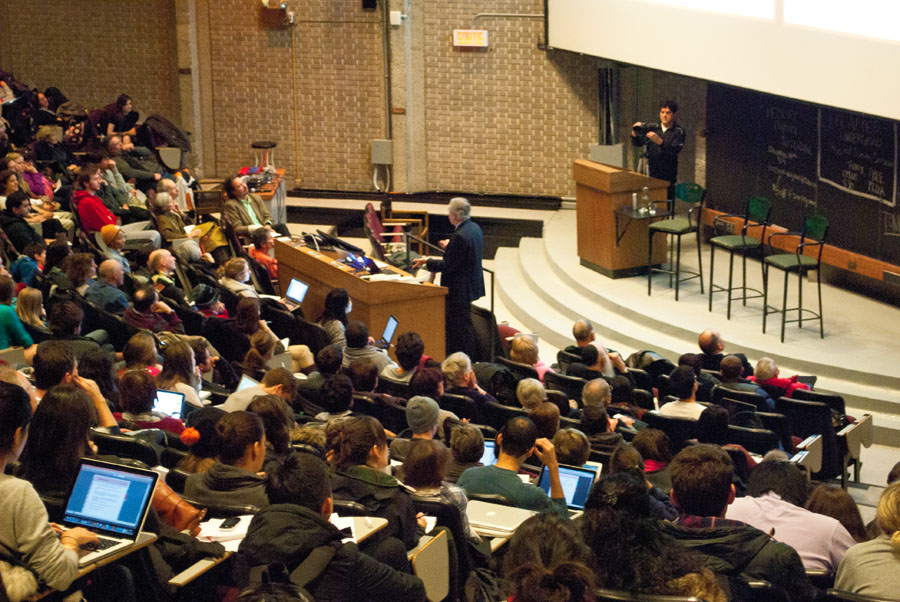"And be sure to say your name before speaking, so I can put you down for participation marks," a teaching assistant instructs a room of blank-faced undergraduate students. An attendance sheet circulates. A pen taps against a desk. To break the silence, someone offers a summary of the week's course reading. It's been four minutes—of a conference that is meant to last an hour.
Most Arts students are well acquainted with mandatory conferences. In a faculty as large as Arts—which had 8,668 students enrolled in Fall 2015—lectures can feel less like classes and more like stadium events. Smaller weekly meetings facilitate the direct participation in peer discussion that just isn’t possible in Leacock 132. These are generally led by teaching assistants (TAs), who are often graduate students in a related area of study. In theory, conferences serve as a helpful and essential supplement to the one-way information channel of a lecture. However, the wide variation and inconsistency between conferences and TAs mean that this end isn't always achieved in practice. The structure of most mandatory Arts conferences—and the patterns of participation that it produces—precludes the meaningful course engagement that conferences are meant to foster. Minor but mindful changes to this format, as well as standardized TA qualifications, could salvage the conference’s often wasted potential.
While it is necessary to incentivize turnout—nothing puts the “mandatory” in mandatory conference quite like attendance marks—a quantitative grading scheme hampers natural discussion dynamics. Granted, sincere interest in a particular course topic sometimes wins out, but that is a rare exception to the rule that governs most low-risk and low-reward obligations—that of minimal possible effort. When it’s 4 p.m. on a Friday afternoon, the average conference attendee wants to speak for just long enough to ensure a tally next to his or her name on the TA’s attendance sheet. The result is often a quantity-over-quality discussion, usually dominated by two or three students while the rest of the class act as Facebook-scrolling, notebook-doodling spectators.
A facilitator—in the form of a TA—ideally prevents such a disjointed, lopsided dynamic. It’s possible to luck out with a TA that is both knowledgeable and an effective mediator, but much like student participation, it’s not guaranteed. TAs are often graduate students for whom the conference is as much a learning experience as it is for the students. That’s not necessarily a bad thing, but it does lead to variation in effectiveness. New teachers can be great, but, as many students are unfortunately aware, new teachers can also be very bad.
At McGill, application criteria for TA positions vary across departments, with no standard requirement of prior teaching experience. Participation in teaching workshops—such as the McGill Teaching and Learning Services’ SKILLSETS—is encouraged, but not always mandatory. As a result, conference experiences vary drastically, and the quality of learning that students receive hinges on the competence of the TA they happen to be assigned to. Mandating participation in such workshops or including a more substantive, standardized requirement of teaching or equivalent experience would help improve the effectiveness of conferences across the board.
Together, flawed structure and inconsistent mediation produce conferences that often fall short of encouraging involvement with a course, and can be even more disaffecting than the lecture itself. However, this does not mean that professors should eliminate mandatory conferences altogether, as they are potentially exceptional teaching tools. When a conference is successful, the results—genuine engagement with a course material, original dialogue with peers, and sound-bytes of information that you actually want to tell your parents about—are invaluable.
The question becomes one of turning this rare experience into the standard. Alterations need not be drastic to yield results: Grading schemes should account for the quality rather than the sheer length of contribution, and the conference should be structured to suit a given course’s content. For example, weekly student presentations—as are current practice in some conferences—work well for clarifying abstract political theory, but might feel dry and repetitive for a fact-heavy history course. Inevitably, half of the battle will always be motivation and discipline on the student’s part. However, steps such as standardized TA training and more course-specific formatting will encourage student engagement with course material and create a conference experience that enriches and involves them.








